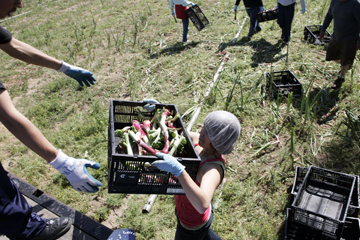
Ag Against Hunger volunteers fill local pantries
Dale and Christine Coke have donated leftover produce from their
San Juan Bautista farm to Ag Against Hunger, a nonprofit that
collects food from growers and shippers to distribute to food banks
in the tri-county area, for quite awhile.
Ag Against Hunger volunteers fill local pantries
Dale and Christine Coke have donated leftover produce from their San Juan Bautista farm to Ag Against Hunger, a nonprofit that collects food from growers and shippers to distribute to food banks in the tri-county area, for quite awhile.
More than 50 shippers and growers in the region donate produce to the group – most straight off their cooler docks.
“We were aware of them being in the community,” Christine said. “We have extra produce so why not feed it to someone who needs it?”
But last year the Cokes became one of fewer than a dozen companies involved with a gleaning program that brings volunteers onto farms to sweep through already harvested fields. On April 26 San Benito students and other volunteers from around the area came out to pick through a field of green onions at the Coke Farm, the couple’s organic farm.
“It works out great,” Christine said. “It brings in volunteers who come in and do the work … provide the goods, but not put out the cost of when you harvest it yourself. We are happy to donate it because it’s not costing us over and above growing the food.”
Their farm was chosen for the launch of the 2008 gleaning season April 26.
“Last Saturday (April 26) they came and gleaned a field of spring onions,” Christine said. “We had 30 people come out and get a lot out.”
She and her husband usually select a field where the volunteers can take whatever they can harvest from about 9 a.m. to 1 p.m., and then they have one of their supervisors oversee the event.
“We think about what would work well, what options we have,” she said. “Usually it’s after we’ve gone through. Some lettuce might be too small or the market might not be so good and we will say, ‘we have this available.'”
Fresh produce is one of the hardest commodities for food banks to stock because staff need to move it in and out quickly before it spoils – most banks have limited cooler storage.
Ag Against Hunger staff work with a variety of local pantries as their first tier receivers. These include Second Harvest Food Bank, Food Banks of Monterey County, Grey Bears and locally, Community Pantry. When they have more than local food banks can accept, the produce goes out to food banks outside of the region. Staff from California Emergency Foodlink, a nonprofit based in Sacramento, will pick up produce at the Ag Against Hunger warehouse in Salinas and distribute it out to rural communities. When they have more left after that, AAH staff distribute to food banks in other western states.
The food is always fresh and ready to eat.
“It’s perfectly good to consume, but the market is very specific about what they can accept,” Christine said.
At the April gleaning season launch, high school students and other kids made up the volunteer corps. Wearing hats or hairnets, gloves and comfortable, close-toed shoes, they gathered spring onions in black baskets. Joanne Britton trimmed the roots off some of the onions after they were gathered by kids such as San Benito High School freshman Kasey Imandt and John Bianchi, a 6-year-old Spring Grove student.
The growers really drive what produce is gleaned, according to Abby Taylor-Silva, the executive director of Ag Against Hunger.
“It all depends on whether they have something in the field,” she said. “Sometimes they just don’t know.”
Many weeks they will not have the exact location of their gleaning site until a week or even days before the Saturday event. Generally they have volunteers meet at their Salinas warehouse for training on how to properly harvest the vegetables or fruit, and then they caravan to the site. Staff will also arrange weekday gleans for companies or schools who want to participate.
“They put so much energy into it,” Taylor-Silva said, of the growers, “And they know it is not going to be wasted. It will help people in need.”
One of the benefits of the gleaning program is that it can serve to educate volunteers about hunger in local communities as well as teach them about how agriculture works.
“We have a very diverse group of people of all ages and all professions and income levels volunteer,” Taylor-Silva said. “The common theme is they really want to participate in a program that helps the community and gets nutritious food to people in need.”
The food is distributed from the AAH warehouse to local pantries or California Emergency Foodlink within 72 hours.
“So those onions, on Monday morning were made available,” Taylor-Silva said. “That’s really key, with Foodlink and food banks, is to be able to get all the produce – it is constantly coming and going. We don’t have a problem with shelflife or products going bad because we are moving it so quickly and have a network of partners.”
For more information about Ag Against Hunger or for the upcoming gleaning schedule, visit www.agagainsthunger.org or call 755-1480.









